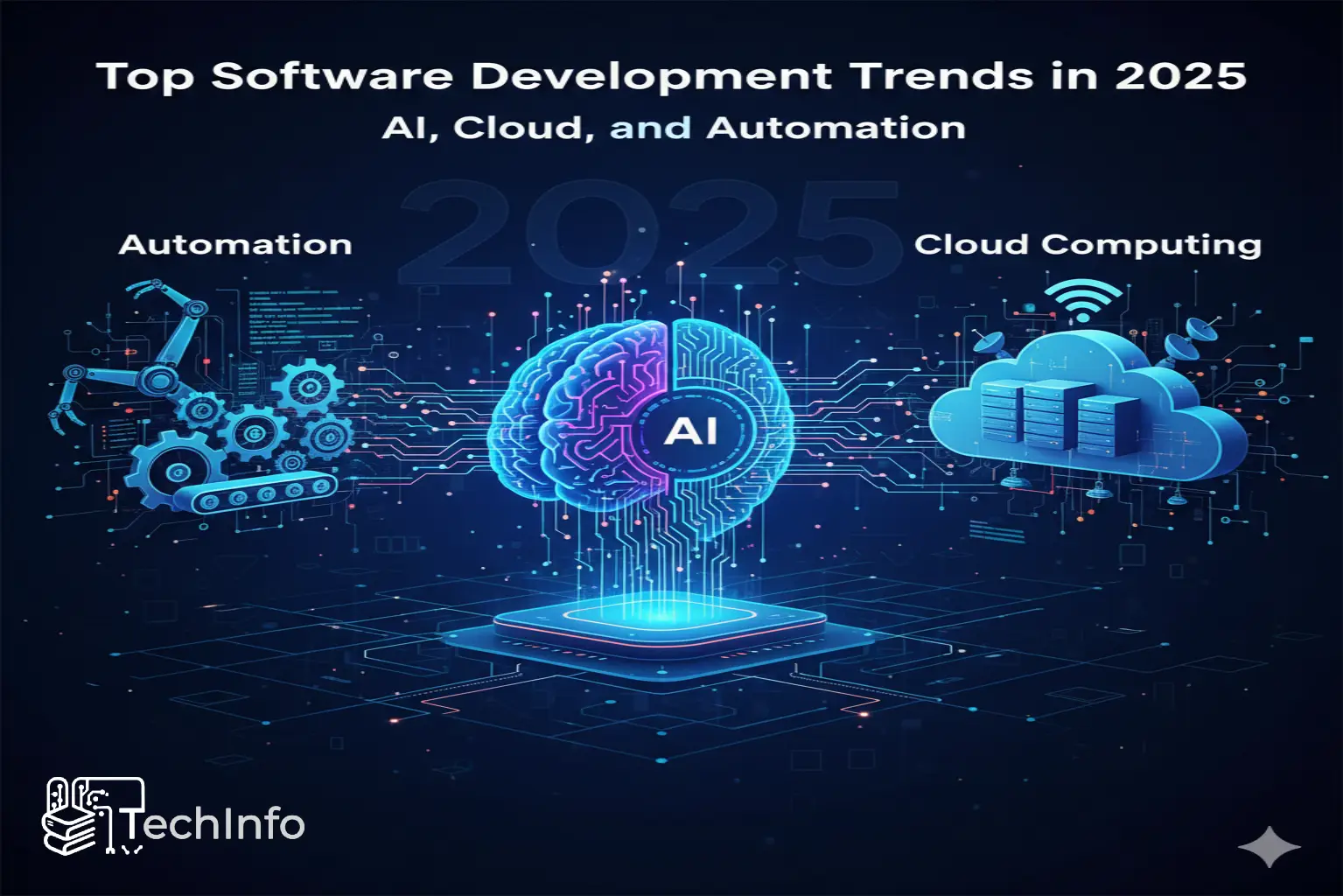Top Software Development Trends in 2025 – AI, Cloud, and Automation
Technology never stands still and in 2025, the software development industry is transforming faster than ever. Artificial Intelligence (AI), Cloud Computing, and Automation are driving this revolution, redefining how developers build, test, and deliver digital products.
But what do these trends mean for businesses and developers? How can they stay competitive in this new digital era? Let’s explore the biggest innovations shaping the world of software development in 2025.
1. Artificial Intelligence: The Engine of Smart Development
AI is no longer an experimental technology. It’s a practical necessity in modern software development. From writing code to testing and deployment, AI is automating tasks that once took hours, freeing developers to focus on innovation.
AI-Powered Development Tools
AI-based tools such as GitHub Copilot and ChatGPT API integrations now assist developers by:
- Suggesting smarter code snippets.
- Predicting errors before they occur.
- Enhancing performance and reducing debugging time.
“Artificial Intelligence isn’t replacing developers, it’s empowering them to create better software faster.”
AI-driven software can also improve user experience by analyzing data patterns and offering real-time customization, making every application more intelligent and adaptive.
2. Cloud Computing: The Backbone of Modern Software
Cloud technology continues to dominate in 2025, allowing developers to build scalable, secure, and accessible applications without heavy infrastructure costs.
The shift toward cloud-native development using containers, microservices, and serverless architecture has become standard practice. It not only improves performance but also allows faster updates and easier maintenance.
For developers looking to optimize their deployment environments, check out our detailed article on modern web hosting solutions for developers. It explores how cloud infrastructure empowers performance, scalability, and reliability in today’s fast-paced digital world.
Multi-Cloud Strategies: More companies are embracing multi-cloud setups, leveraging AWS, Google Cloud, and Azure simultaneously to prevent vendor lock-in and improve uptime. This hybrid approach ensures flexibility and data redundancy, key to modern app resilience.
3. Automation: Streamlining the Software Lifecycle
Automation is transforming every stage of software development, from writing and testing code to deployment and monitoring. DevOps tools and Continuous Integration/Continuous Deployment (CI/CD) pipelines are leading this movement.
With automated testing and deployment, businesses can now deliver updates in minutes instead of days while maintaining consistent quality.
DevOps Evolution: DevOps teams are integrating AI and analytics into their workflows, making automation smarter and adaptive. For example, predictive analytics can now identify potential system failures before they happen, minimizing downtime and maintenance costs.
“Automation isn’t about removing humans—it’s about removing bottlenecks.”
4. The Merge of AI and Cloud: Intelligent Infrastructure
When AI meets the Cloud, something incredible happens: smart infrastructure. Cloud-based AI systems analyze real-time data to make automated decisions, optimize costs, and personalize user experiences.
Businesses are now deploying AI-driven cloud applications that scale automatically based on demand and even optimize energy consumption. This synergy between AI and the cloud marks a new era of self-managing software.
5. User-Centric Design: Where Function Meets Experience
As technology becomes more powerful, user experience (UX) has become the ultimate differentiator. Software is no longer judged solely on performance; it’s judged on how seamlessly it interacts with users.
That’s why UI/UX-driven development is trending in 2025. Developers are collaborating closely with designers to ensure software is not only functional but also visually engaging and intuitive.
If you’re looking for inspiration on how design elevates technology, explore our in-depth post about innovative web design that enhances user experience. It highlights how modern design principles can turn simple software into a memorable brand experience.
6. Cybersecurity-First Development
With the rise of digital transformation comes the rise of cyber threats. In 2025, security is not a feature—it’s a foundation.
Developers are adopting “shift-left security” approaches, embedding security checks early in the development process. This proactive mindset helps identify vulnerabilities before deployment, ensuring robust and resilient software systems. Zero-trust architectures are also gaining traction, verifying every request, user, and device that interacts with a system, making breaches far less likely.
7. The Rise of Low-Code and No-Code Platforms
The democratization of development continues with low-code and no-code solutions. These platforms allow even non-developers to create applications through drag-and-drop interfaces—accelerating innovation and reducing dependency on IT teams.
In 2025, startups and small businesses are using these platforms to build MVPs (Minimum Viable Products) quickly, test market ideas, and scale without high technical barriers.
8. Sustainable and Green Software Development
Sustainability has become a priority across industries, including software. Developers are now writing energy-efficient code, choosing green hosting providers, and minimizing server load to reduce their carbon footprint.
Cloud providers like Google and AWS now offer carbon-tracking tools to help developers measure and offset environmental impact—proving that innovation and sustainability can go hand in hand.
Conclusion: Building the Future of Software in 2025
Software development in 2025 is defined by intelligence, speed, and user experience. AI is making developers smarter. Cloud computing is making software faster and more reliable. Automation is making the entire process seamless. The fusion of these three trends is reshaping industries, businesses, and the daily lives of millions.
In the years ahead, developers who embrace AI-driven tools, leverage cloud-native architectures, and design with user-first principles will lead the digital revolution. Because in 2025, software isn’t just built—it evolves, learns, and adapts.







